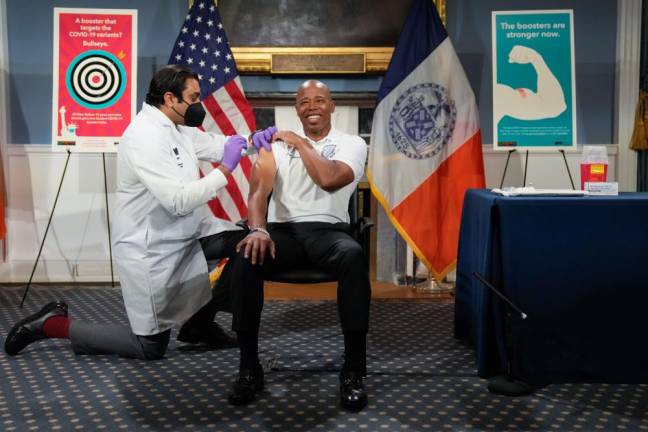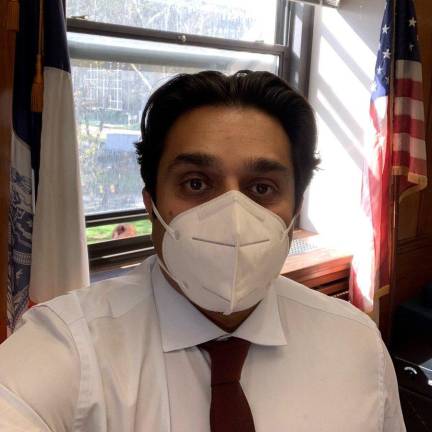Vaccine Angst
A new debate over the return on investment (ROI) of the COVID jabs


For a brief moment we greeted those vaccines as our salvation from COVID-19, scrambling for appointments and celebrating our jabs as liberation from masks, social distancing and lockdowns. But then the realization settled in that vaccination is medicine not magic.
The focus turned from the significant protections provided by the vaccines to their imperfections, culminating Saturday in a New York Post headline that read: “Stop Wasting Money Pushing COVID Booster.”
Dr. Joel Zinberg, a former Mount Sinai surgeon who served as an economic adviser to ex-President Donald Trump, complained that President Biden had pilfered – the good doctor’s word – millions of dollars meant for other pandemic relief to pay for what the president’s COVID adviser, Dr. Ashish Jha, calls a “six-week sprint” to juice the lackluster uptake of the new bivalent vaccines, which are designed to fight the newest strains.
Zinberg did not point out that Biden is taking the money because Congress refused to appropriate new funds for more vaccines. Instead, Zinberg argued that it is a waste to try to convince skeptical Americans to take jabs they no longer believe they need. Overcoming that skepticism is, of course, the core messaging of the President’s six-week sprint.
But behind this debate, such as it is, is a more basic question that has been answered for the first time by a group of researchers that included Dr. Dave Chokshi, the city’s former health commissioner:
“Did the economic savings accrued from reductions in COVID-19 cases, hospitalizations and deaths outweigh the investment in the COVID-19 vaccination program in New York City?”
For all our recent angst about vaccination, the answer, the researchers say, is unequivocally yes.
“Every $1 invested in the New York City vaccination campaign yielded an estimated $10.19 in cost savings from lower infection and mortality rates, fewer productivity losses, and averted health care use,” the researchers reported in JAMA Network Open, an online publication of the Journal of the American Medical Association.
Computer Model
The researchers, lead by Alison P. Galvani of the Yale School of Public Health, compared the first year of vaccination in New York City (December 14, 2021 to January 21, 2022) with what a computer model suggested would have happened without the vaccine.
“New York City, an early epicenter of the pandemic, invested heavily in its COVID-19 vaccination campaign to mitigate the burden of disease outbreaks,” the researchers wrote. “Understanding the return on investment (ROI) of this campaign would provide insights into vaccination programs to curb future COVID-19 outbreaks.”
In other words, a direct answer to Zinberg’s complaint about President Biden’s current six-week vaccination sprint.
“Findings of this study suggest that COVID-19 vaccination in New York City was associated with reduction in severe outcomes and avoidance of substantial economic losses,” Galvani, Chokshi and their colleagues wrote.
“This significant ROI supports continued investment in improving vaccine uptake during the ongoing pandemic.”
Viruses Spreading Together
With COVID and other respiratory viruses all spreading together as we head into winter, the future of the vaccine effort is an immediate and urgent concern. Close to nine New Yorkers in ten have gotten at least an initial vaccine dose (98 percent in Manhattan). But the numbers fall precipitously from there. Only 40% have gotten any booster doses at all and fewer than one in ten have gotten the new booster, even though the city’s health department says “the updated bivalent boosters are the single greatest protection available to them in addition to the use of face coverings in crowded indoor settings and staying home when they are sick.”
The department said that reminding New Yorkers of this is their top priority this fall.
Obviously, the past is a less that perfect predictor of the future. The value of booster doses may not be the same as of the original inoculation series distributed during the period of the study.
Nevertheless, the study found that the value (the ROI, if you prefer) was very large.
The direct cost of the New York City vaccination campaign, the researchers reported, was $2.44 billion. They attributed an additional indirect cost of $2.39 billion due to time off from work to get vaccinated or recover from adverse reactions.
Value of Lives Saved
Despite the vaccination campaign, New York still had to spend $7.45 billion on direct health care costs to fight COVID, everything from ambulance runs to hospitalizations. But that paled to the $33 billion the researchers estimate would have been the health costs absent the protections of vaccination.
“Overall, vaccination was estimated to have averted $27.96 billion of additional direct and indirect health care costs that would have incurred without vaccination.”
The researchers also estimated the value of the lives saved, using a sometimes chilling but widely accepted actuarial measure. They estimated this savings at $26.27 billion dollars, which is how they got to every dollar spent on vaccination returned more than $10.
But even without including the imputed value of a human life, they noted, the ROI was still $4.27 for every dollar spent on vaccination.
“The New York City COVID-19 vaccination campaign was found to be associated with not only reduction in severe outcomes but also avoidance of substantial economic losses from high costs of health care and value of lives lost. This considerable ROI provides compelling evidence for the continued investment in improving vaccine uptake during the ongoing COVID-19 pandemic.”
“Overall, vaccination was estimated to have averted $27.96 billion of additional direct and indirect health care costs that would have incurred without vaccination.” From the JAMA Network Open report